Abstract
Mixed grinding with Na2S followed by water leaching was performed to extract Li from lepidolite. The leachability of Li increases dramatically in the ground mixture, regardless of the mixing ratio over the range of 1:1 to 3:1, while only 4.53% of Li was extracted in lepidolite ground without Na2S. The leachability increased with an increase of the grinding time, and ultimately, 93% of the Li was leached by water from the ground mixture with a weight ratio of 3:1 (Na2S:Lepidolite). In the process of the mixed grinding, the Li-contained lepidolite was destructured crystallographically, and it might have changed to different compounds. This process enables us to extract Li from lepidolite via a water leaching treatment.
1. Introduction
Lithium (Li), the lightest metal in nature, has unique electrochemical properties and the highest specific heat of the solid elements. Moreover, some lithium compounds possess flat viscosity/temperature ratios. Due to these fascinating properties, Li and its compounds have attracted much attention for use in various applications in the ceramics, glass, lubrication, pharmaceutical industries as well as the battery/fuel cell industry [1,2]. Currently, the main consumption of Li is in the glass/ceramics manufacturing industry, where Li lowers the melting point of the glass and ceramics [3,4] and for light weight Li-ion batteries. As the Li-ion batteries used in future electric and hybrid vehicles will greatly increase the demand for Li, the global Li market consumption, measured as Li carbonate equivalents, is expected to increase dramatically, from 120,000 in 2011 to 160,000 ton in 2015 [5,6,7].
The main sources of Li are natural brines and minerals. Natural brines refer to lakes, salars, oilfield and geothermal brines, which are found principally in Argentina, Bolivia, Chile, China and the USA. Currently, these brines are the dominant source for worldwide Li-production because of not only the lower production costs but also the much simpler process compared with the processes for pegmatitic minerals. Nevertheless, many research studies have been recently conducted regarding Li extraction from minerals, such as spodumene, zinnwaldite, and lepidolite, because of the persistent and tremendous growth in demand that is forecasted for Li batteries that will be used to power both hybrid and fully electric automobiles [8]. Among these minerals, Li extraction processes from lepidolite (K(Li,Al)3(Si,Al)4O10(F,OH)2) have been researched actively because of their wide spread distribution, the characteristic of being poor in iron, and the additional content of rare metals, such as rubidium (Rb) and cesium (Cs) [5,9,10,11]. These processes are composed to two stages: Sulfation and water leaching. Sulfation is conducted using the sulfuric acid method and the lime method. However, the extraction of Li by the sulfuric acid method uses a high concentration of acid, and the purification procedure is complex. In addition, the lime method uses limestone and requires a large amount of energy. To accomplish a higher Li extraction of over 90% by water leaching from lepidolite (K(Li,Al)3(Si,Al)4O10(F,OH)2), it must be heated with water steam for defluorination [11,12,13,14]. These drawbacks limit the availability of lepidolite as a lithium main source. To overcome these drawbacks, our research group tested the applicability of mechanochemical treatment for Li extraction from lepidolite without thermal treatment of sulfation and defluorination. This study may provide information for the use of low grade lepidolite as a source in Li production.
2. Experimental Section
2.1. Materials
The lithium-contained lepidolite was provided by the Boam mine (Uljin, Korea), and it was upgraded through crushing and optical sorting treatment. The crushing was carried out by jaw crusher (BICO Ltd., Burbank, CA, USA) with open setting at 100 mm of width and 10 mm of gap. The first upgraded lepidolite was subjected to grinding via a rod mill at 60 rpm and then was screened with a #200 sieve (aperture size: 74 μm) for a complete pass. The material that was ground to 74 μm or under was used in this study as a starting material, and its phases were identified by using high resolution X-ray diffraction (HRXRD, X’pert-Pro MPD, PANalytical, Almelo, The Netherland) using Cu-Kα radiation (λ = 1.5406 Å).
As shown in Figure 1, the starting material was primarily quartz (SiO2, JCPDs No. 87-2096, Ⓠ), muscovite (K(OH,F2)2Al3Si3O10, JCPDs No. 7-0042, Ⓜ), and lepidolite (KLiAl(OH,F)2Al(SiO4)3, JCPDs No. 76-0535, Ⓛ). Moreover, the chemical composition, as presented in Table 1, was analyzed by X-ray fluorescence (XRF, X-ray Fluorescence, S2 ranger, Bruker, Billerica, MA, USA), and the lithium content was measured by using an Inductively Coupled Plasma spectrometer (ICP, OPTIMA 7300DV, Perkin Elmer, Waltham, MA, USA), after chemical digestion treatment. Moreover, a total mass loss of ~3.3% was measured by thermogravimetric analysis (TGA) at 1000 °C.
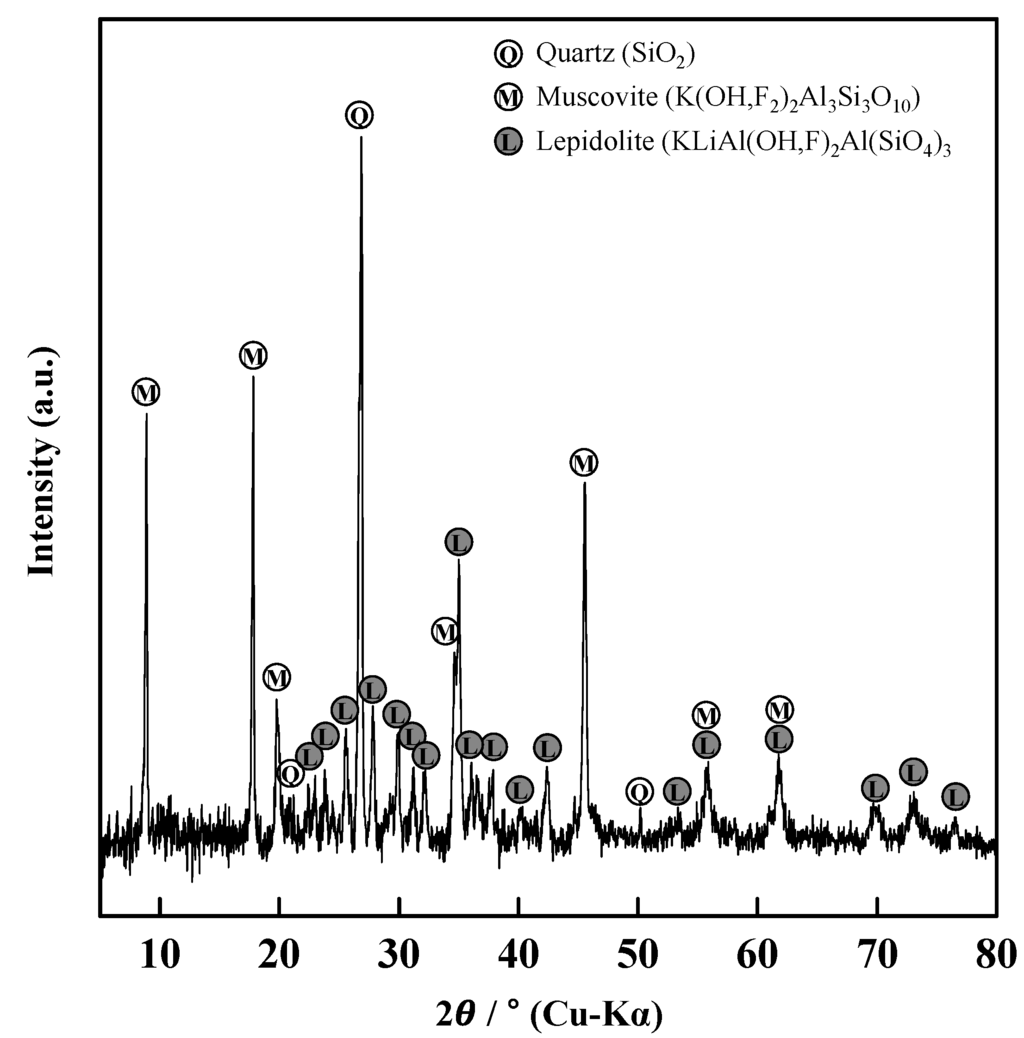
Figure 1.
X-ray diffraction (XRD) pattern of the first upgraded lepidolite used in this study.

Table 1.
Composition (%) of the first upgraded lepidolite analyzed by X-ray fluorescence (XRF) and Inductively Coupled Plasma spectrometer (ICP).
| Al2O3 | SiO2 | K2O | CaO | MnO | Fe2O3 | Rb2O | Cs2O | Li |
|---|---|---|---|---|---|---|---|---|
| 28.76 | 55.12 | 12.83 | 1.04 | 0.3 | 0.16 | 1.46 | 0.33 | 1.74 |
2.2. Intensive Grinding with Sodium Sulfide (Na2S)
As a grinding additive for increasing the lithium solubility, sodium sulfide (Na2S, SS), was used in this study. SS was prepared from sodium sulfide nonahydrate (Na2S·9H2O, 96%), supplied from Junsei Chemical Co., Ltd. (Tokyo, Japan), which was calcined at 120 °C for 6 h for dehydration. The mixture of upgraded lepidolite (UL) and SS was used to produce samples of different weight ratios (UL:SS), ranging from 1:1 to 1:3, and these different mixtures were kept in a desiccator. To grind each mixture intensively, a planetary ball mill (Pulverizette-7, Fritsch Gmbh, Idar-Oberstein, Germany) was used. The mill conditions were as follows: 4 g of each mixture was placed into a zirconia pot (45 cm3 inner volume) with seven 15-mm diameter zirconia balls and then was subjected to grinding in air at 700 rpm for various periods of time.
2.3. Water Leaching for the Ground Mixture of Lepidolite and Sodium Sulfide
Subsequently, the ground mixture was leached with distilled water using the following conditions: Room temperature, slurry density (20 g/L), stirring by magnetic bar, and leaching time (30 min). To acquire more accurate data for Li leachability, the content of Li was analyzed not only for the leached solution but also for the leached residue after chemical digestion. The leachability of Li was calculated according to the following equation:
where Li content (A) is the Li mass calculated from the Li concentration in the leached solution, and Li content (B) represents the Li mass in the leached residue after complete dissolution. Figure 2 presents the flow sheet of the experimental procedure in this study.
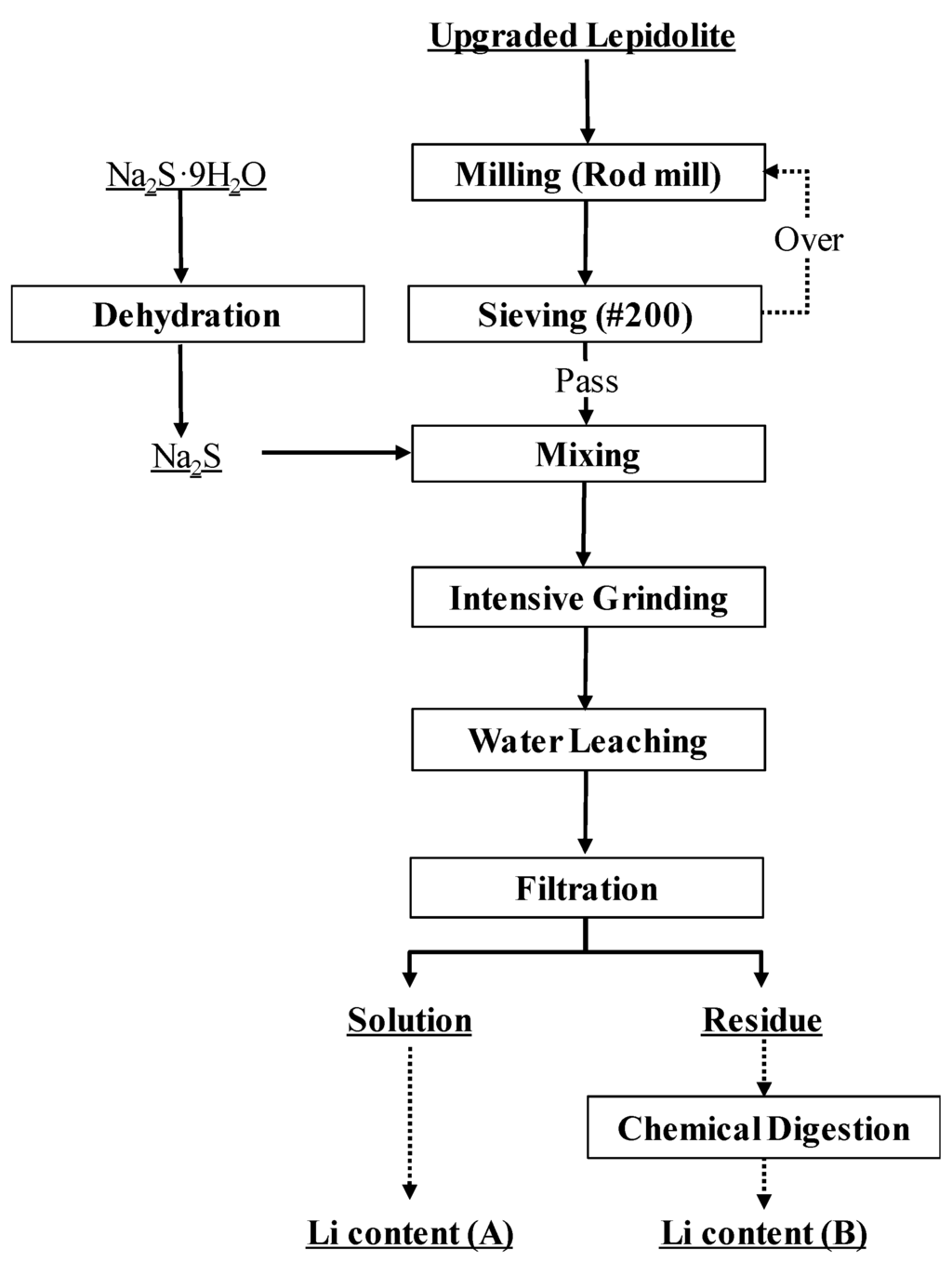
Figure 2.
Flow chart summarizing the all the processes used in this study.
3. Results and Discussion
3.1. The Change of Li-Leachability from Lepidolite
To investigate the effect of additives and grinding on lithium leachability from lepidolite, a series of experiments were performed. The mixture ratio of (UL:SS) was changed from (1:1) to (1:3), and the durations of grinding for different samples were over the range of 0 to 12 h. Subsequently, each of the ground mixtures was leached for 30 min with distilled water. To compensate for the inhomogeneity of the Li content in lepidolite, the leaching test of each condition was replicated, and the result was taken as the mean value of three experiments.
The results of leaching were summarized in Figure 3. As shown in this figure, Li in UL was rarely dissolved (4.54%) without the additive SS, even if intensive grinding was performed for 12 h. Meanwhile, in the case of grinding with SS, the results confirm the favorable influence of intensive grinding on the leachability of Li from UL. Regardless of the mixing ratio, the leachability increases dramatically with an increase of the grinding time. Regarding the mixing ratio of 1:1 (SS:UL), the leachability increased steadily to 84.4% as a function of a grinding time of up to 6 h. Subsequently, the leachability decreased slightly to 82%, even though the grinding progressed to 12 h. A similar tendency for the relationship between Li yield and the grinding time could be verified in the case of the mixture at the ratio of 2:1 (SS:UL). Leachability (90.9%) was accomplished by water leaching from the mixture ground for 6 h, and it decreased slightly to 90.06% for longer grinding times. Meanwhile, the leachability from the mixture at the ratio of 3:1 (SS:UL) increased consistently with the grinding time, although the gradient decreased progressively for further grinding. These leachabilities were confirmed to be 83% (from the mixture ground for 3 h), 90.1% (for 6 h), and 93% (for 12 h). In general, intensive grinding results in the enhancement of the leaching reaction due to an increased specific surface area, enhanced surface reactivity and changes in crystalline structure for various materials, which include minerals. In this study, leaching of Li from only the ground UL has little effect (maximum leachability of Li: 4.65%), which suggests that an increase of the finely ground particles is not the major factor that influence the leachability of Li. To achieve a Li extraction of 90% and above from UL, UL needs to be mixed with SS to at least the weight ratio of 2:1 (SS:UL) and with the subsequent grinding of this mixture is to be ground for 6 h or more.
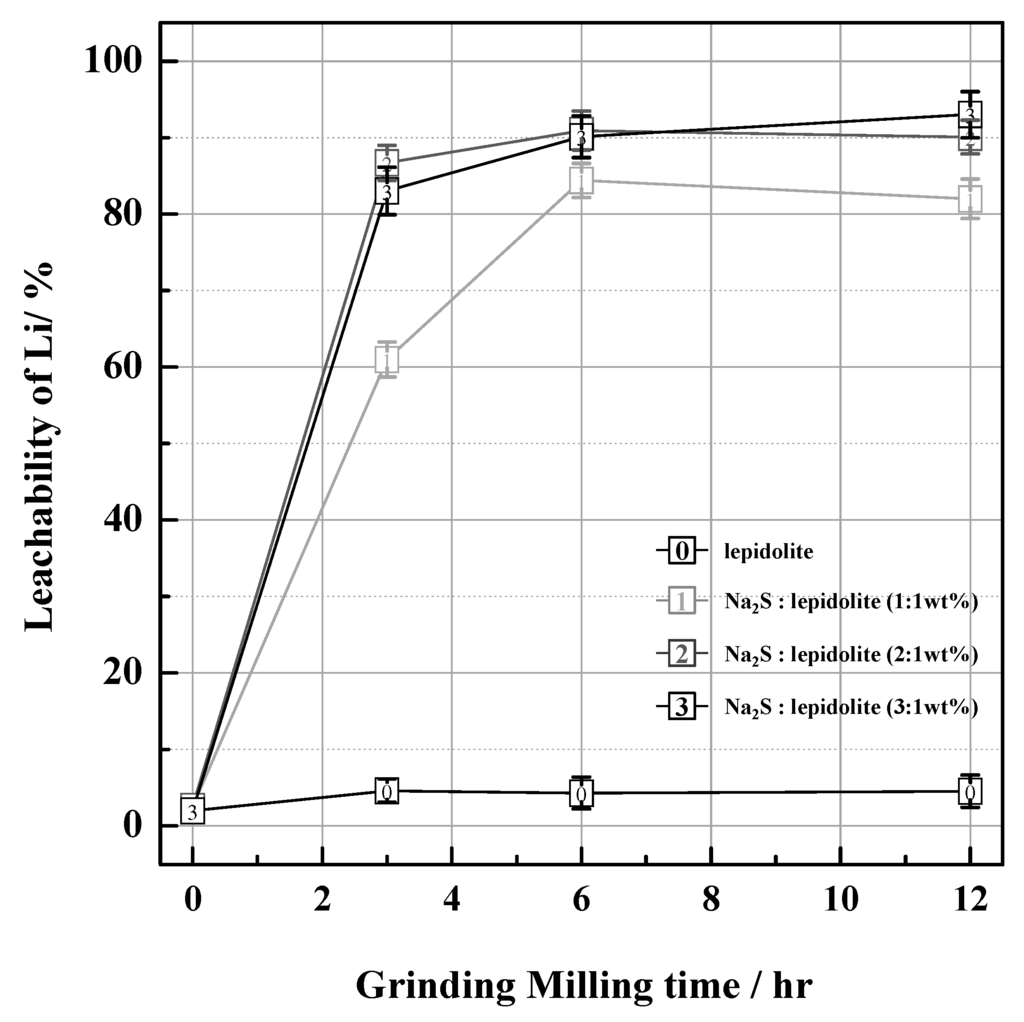
Figure 3.
Leachability of Li from the mixture of sodium sulfide (SS) and lepidolite (UL) with a change of the mixing ratio and grinding time.
3.2. Structural Changes of the Mixture (SS and UL) via Intensive Grinding
To verify the grinding effect of the mixture (SS and UL) on leaching, X-ray diffraction (XRD) analysis was performed on the ground mixture of 3:1 (SS:UL). This analysis was focused on the structural change of the primary constituents in the starting material, such as quartz, muscovite and lepidolite. The upgraded lepidolite (UL) was mixed with Na2S (SS) at a mass ratio of 1:3, and then, the mixture was ground intensively by using a planetary ball mill for various periods of time, ranging from 180 to 600 min (Figure 4).
As shown in Figure 4, most peaks of UL in the mixture that were ground for only 3 h, such as quartz, muscovite and lepidolite, disappeared, while all of the peaks were confirmed for sodium sulfide (Na2S), sodium sulfate (Na2SO3, JCPDs No. 70-1909), and hydrated sulfide (Na2S·(H2O)5, JCPDs No. 84-0662). This result implies that the structure of UL may be destroyed considerably by intensive grinding with SS. Moreover, SS may be partially oxidized and hydrated during the grinding procedure in atmosphere condition. The structural changes of lepidolite in the XRD patterns were hardly analyzed due to low content of lepidolite and the comparatively higher content of sodium sulfide.
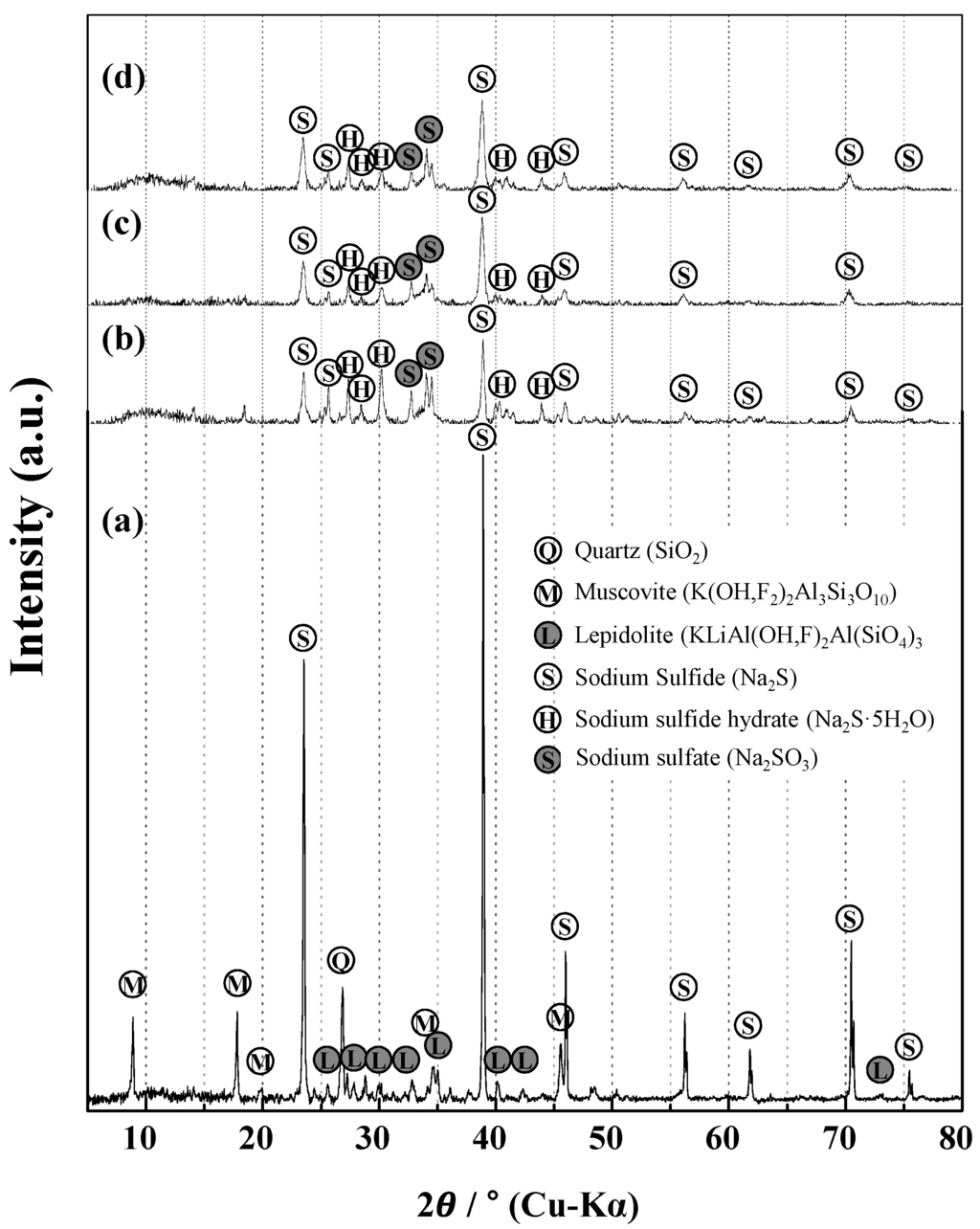
Figure 4.
XRD pattern of the mixture (UL:SS = 1:3) with the change of the grinding time, ((a) only mixed; (b) 3 h; (c) 6 h; (d) 12 h).
As mentioned above, to detect the structural changes of UL in the mixture that was ground intensively using an XRD analyzer, it is necessary to improve the crystal quality. In this study, thermal treatment for annealing of the ground mixture was performed at 105 °C for 2 h.
In Figure 5, the main peaks of muscovite and lepidolite are summarized. As shown in the figure, all of the main peaks of muscovite and lepidolite disappeared by grinding for only 3 h. Moreover, none of their peaks can be detected in the ground mixture annealed at 105 °C. This result implies that muscovite and lepidolite may be changed to entirely different compounds, and not only simply to the amorphous state.
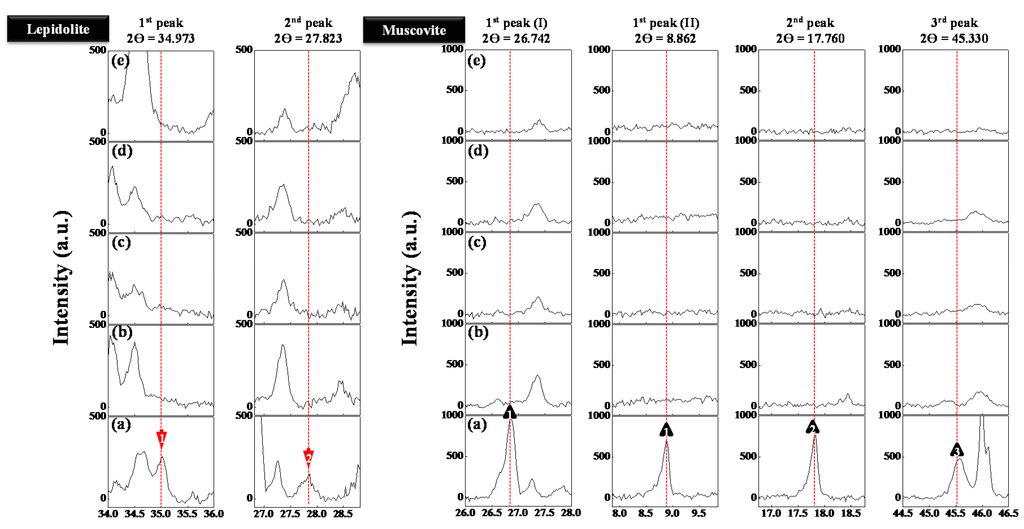
Figure 5.
The change of the main peaks for lepidolite and muscovite in the mixture (UL:SS = 1:3) at various grinding times ((a) only mixed; (b) 3 h; (c) 6 h; (d) 12 h; (e) annealed with the mixture ground for 12 h).
4. Conclusions
Due to the need for new processes capable of recovering lithium from low-graded Li-contained minerals, grinding a mixture of UL and SS under atmospheric conditions using a planetary ball mill was conducted, and subsequently, the Li in the ground mixture was leached by distilled water at room temperature. The following conclusions can be made based on the experimental results.
In spite of intensive grinding for 12 h, only 4.53% of Li could be leached by distilled water from the ground UL. Meanwhile, the leachability increased dramatically with an increase of grinding time for various mixing ratios of SS to UL. Regarding the ground mixtures (SS:UL) of 1:1 and 2:1, the leachability of Li increased consistently until 6 h, and then, it decreased slightly, even though the grinding proceeded to 12 h. However, the leachability of Li in the ground mixture of 3:1 increased consistently with grinding time, and 93% leachability was accomplished ultimately.
As a result of the analysis of the crystallographic data for the ground mixtures, the Li-contained minerals, such as lepidolite and muscovite, were destructured by intensive grinding with SS and were changed entirely to different compounds. This process enables us to accomplish 93% of Li-leachability using the water leaching treatment.
Acknowledgments
This work was supported by the Energy Efficiency & Resources of the Korea Institute of Energy Technology Evaluation and Planning (KETEP) granted funded by the Korea government Ministry of Knowledge Economy (No. 2010T100200203), and by 2014 Research Grant from Kangwon National University (No. 120140369).
Conflicts of Interest
The authors declare no conflict of interest.
References
- Ebensperger, A.; Maxwell, P.; Moscoso, C. The lithium industry: Its recent evolution and future prospects. Resour. Policy 2005, 30, 218–231. [Google Scholar] [CrossRef]
- Moon, K.S.; Fuerstenau, D.W. Surface crystal chemistry in selective flotation of spodumene (LiAl[SiO3]2) from other aluminosilicates. Int. J. Miner. Process. 2003, 72, 11–24. [Google Scholar] [CrossRef]
- Garrett, D.E. Handbook of Lithium and Natural Calcium Chloride Their Deposits Processing Uses and Properties; Elsevier: Amsterdam, The Netherland, 2012. [Google Scholar]
- Sitando, O.; Crouse, P.L. Processing of a Zimbabwean petalite to obtain lithium carbonate. Int. J. Miner. Process. 2012, 102, 45–50. [Google Scholar] [CrossRef]
- Jandová, J.; Dvořák, P.; Vu, H.N. Processing of Zinnwaldite waste to obtain Li2CO3. Hydrometallurgy 2010, 103, 12–18. [Google Scholar] [CrossRef]
- Silame, E.; Pascoe, R.D. Extraction of lithium from micaceous waste from china clay production. Miner. Eng. 2011, 24, 1595–1602. [Google Scholar]
- Vu, H.; Bernardi, J.; Jandová, J.; Vaculíková, L.; Goliáš, V. Lithium and Rubidium extraction from Zinnwaldite by alkali digestion process: Sintering mechanism and leaching Kinetics. Int. J. Miner. Process. 2013, 123, 9–17. [Google Scholar] [CrossRef]
- Mohr, S.H.; Mudd, G.M.; Giurco, D. Lithium resources and production: Critical assessment and global projections. Minerals 2012, 2, 65–84. [Google Scholar] [CrossRef]
- Ogorodova, L.P.; Kiseleva, I.A.; Melchakova, L.V.; Schuriga, T.N. Thermodynamic properties of lithium mica: Lepidolite. Thermochim. Acta 2005, 435, 68–70. [Google Scholar] [CrossRef]
- Yan, Q.; Li, X.; Wang, Z.; Wu, X.; Guo, H.; Hu, Q.; Peng, W.; Wang, J. Extraction of valuable metals from lepidolite. Hydrometallurgy 2012, 117, 116–118. [Google Scholar] [CrossRef]
- Yan, Q.; Li, X.; Wang, Z.; Wu, X.; Wang, J.; Guo, H.; Hu, Q.; Peng, W. Extraction of lithium from lepidolite by sulfation roasting and water leaching. Int. J. Miner. Process. 2012, 110, 1–5. [Google Scholar] [CrossRef]
- Luong, V.T.; Kang, D.J.; An, J.W.; Kim, M.J.; Tran, T. Factors affecting the extraction of lithium from lepidolite. Hydrometallurgy 2013, 134, 54–61. [Google Scholar] [CrossRef]
- Yan, Q.; Li, X.; Yin, Z.; Wang, Z.; Guo, H.; Peng, W.; Hu, Q. A novel process for extracting lithium from lepidolite. Hydrometallurgy 2012, 121, 54–59. [Google Scholar] [CrossRef]
- Yan, Q.; Li, X.; Wang, Z.; Wang, J.; Guo, H.; Hu, Q.; Peng, W.; Wu, X. Extraction of lithium from lepidolite using chlorination roasting-water leaching process. Trans. Nonferrous Metals Soc. China 2012, 22, 1753–1759. [Google Scholar] [CrossRef]
© 2015 by the author; licensee MDPI, Basel, Switzerland. This article is an open access article distributed under the terms and conditions of the Creative Commons by Attribution (CC-BY) license (http://creativecommons.org/licenses/by/4.0/).